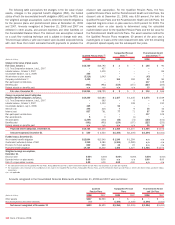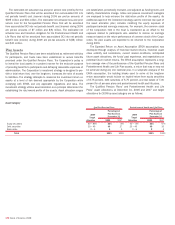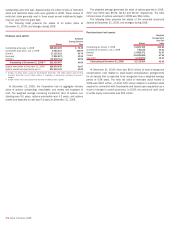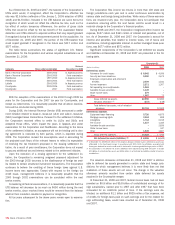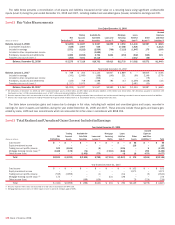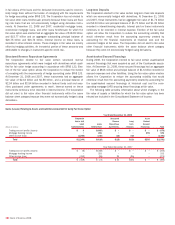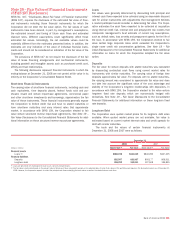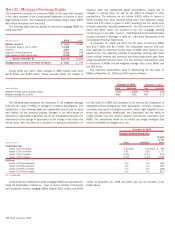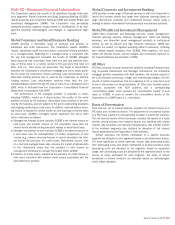Bank of America 2008 Annual Report Download - page 178
Download and view the complete annual report
Please find page 178 of the 2008 Bank of America annual report below. You can navigate through the pages in the report by either clicking on the pages listed below, or by using the keyword search tool below to find specific information within the annual report.Structured Reverse Repurchase Agreements and Long-term
Deposits
The fair values of structured reverse repurchase agreements and long-
term deposits are determined using quantitative models, including dis-
counted cash flow models that require the use of multiple market inputs
including interest rates and spreads to generate continuous yield or pric-
ing curves and volatility factors. The majority of market inputs are actively
quoted and can be validated through external sources, including brokers,
market transactions and third-party pricing services. The Corporation does
incorporate, consistent with the requirements of SFAS 157, within its fair
value measurements of long-term deposits the net credit differential
between the counterparty credit risk and our own credit risk. The value of
the net credit differential is determined by reference to existing direct
market reference costs of credit, or where direct references are not avail-
able, a proxy is applied consistent with direct references for other
counterparties that are similar in credit risk.
Trading Account Assets and Liabilities and Available-for-Sale Debt
Securities
The fair values of trading account assets and liabilities are primarily
based on actively traded markets where prices are based on either direct
market quotes or observed transactions. The fair values of AFS debt
securities are generally based on quoted market prices or market prices
for similar assets. Liquidity is a significant factor in the determination of
the fair values of trading account assets or liabilities and AFS debt secu-
rities. Market price quotes may not be readily available for some posi-
tions, or positions within a market sector where trading activity has
slowed significantly or ceased such as certain CDO positions and other
ABS. Some of these instruments are valued using a net asset value
approach, which considers the value of the underlying securities. Under-
lying assets are valued using external pricing services, where available, or
matrix pricing based on the vintages and ratings. Situations of illiquidity
generally are triggered by the market’s perception of credit uncertainty
regarding a single company or a specific market sector. In these
instances, fair value is determined based on limited available market
information and other factors, principally from reviewing the issuer’s
financial statements and changes in credit ratings made by one or more
rating agencies.
Derivative Assets and Liabilities
The fair values of derivative assets and liabilities traded in the
over-the-counter market are determined using quantitative models that
require the use of multiple market inputs including interest rates, prices,
and indices to generate continuous yield or pricing curves and volatility
factors, which are used to value the position. The majority of market
inputs are actively quoted and can be validated through external sources,
including brokers, market transactions and third-party pricing services.
Estimation risk is greater for derivative asset and liability positions that
are either option-based or have longer maturity dates where observable
market inputs are less readily available or are unobservable, in which
case, quantitative-based extrapolations of rate, price or index scenarios
are used in determining fair values. The fair values of derivative assets
and liabilities include adjustments for market liquidity, counterparty credit
quality and other deal specific factors, where appropriate. Consistent with
the way the Corporation fair values long-term deposits as previously dis-
cussed, the Corporation incorporates, within its fair value measurements
of over-the-counter derivatives, the net credit differential between the
counterparty credit risk and our own credit risk. An estimate of severity of
loss is also used in the determination of fair value, primarily based
on historical experience, adjusted for recent name specific expectations.
Mortgage Servicing Rights
The fair values of MSRs are determined using models which depend on
estimates of prepayment rates, the resultant weighted average lives of
the MSRs and the OAS levels. For more information on MSRs, see Note
21 – Mortgage Servicing Rights to the Consolidated Financial Statements.
Loans Held-for-Sale
The fair values of LHFS are based on quoted market prices, where avail-
able, or are determined by discounting estimated cash flows using inter-
est rates approximating the Corporation’s current origination rates for
similar loans adjusted to reflect the inherent credit risk.
Other Assets
The Corporation fair values certain other assets including AFS equity
securities and certain retained residual interests in securitization
vehicles. The fair values of AFS equity securities are generally based on
quoted market prices or market prices for similar assets. However,
non-public investments are initially valued at transaction price and sub-
sequently adjusted when evidence is available to support such adjust-
ments. Retained residual interests in securitization vehicles are based on
certain observable inputs such as interest rates and credit spreads, as
well as unobservable inputs such as estimated net charge-off and pay-
ment rates.
Asset-backed Secured Financings
The fair values of asset-backed secured financings are based on external
broker bids, where available, or are determined by discounting estimated
cash flows using interest rates approximating the Corporation’s current
origination rates for similar loans adjusted to reflect the inherent credit
risk.
176
Bank of America 2008




